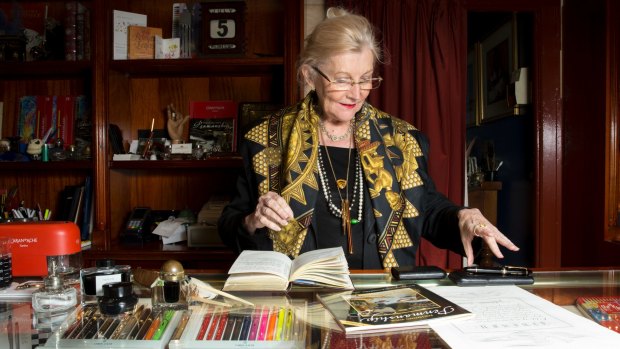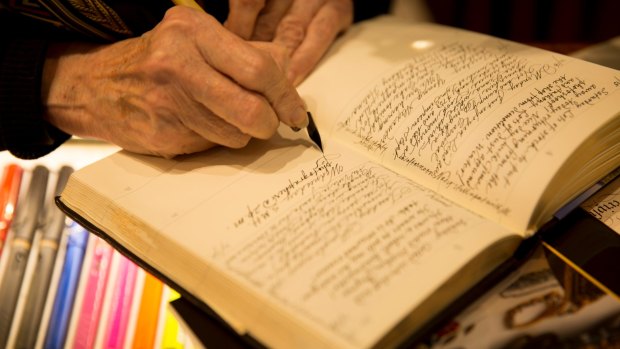This was published 6 years ago
Handwriting 101: The easy ways to improve your scrawl
At the beginning of our handwriting lesson, Barbara Nichol asks me to write my name, then a sentence she dictates. It's like being back at school, which makes sense as Nichol was a school teacher for many years. Judging by her manner now, she would have been an encouraging one, firm but fair.
Nichols' obsession with writing began when she started school in Queensland.

"Practise each day until you have what you like," says Barbara Nichol. Credit: Tammy Law
"To write words in your own hand makes them belong to you, managing the twists and turns and different letter combinations," she says.
We are sitting at a cafe on the top floor of the QVB, near Pen Ultimate, one of two pen stores Nichol owns in Sydney; she has another two in Brisbane, where she is based.

Barbara Nichol's obsession with writing began when she started school in Queensland.Credit: Tammy Law
I am here because Nichol claims to be able to improve your handwriting in one lesson.
"People think it's going to be as hard as learning a language," she says. "It's much easier with just a little tuition."
I have been a writer almost all my life, from creating stories at school, keeping diaries and corresponding with penfriends as a teenager, to making a living as a journalist. I also exchanged letters for two years (pre-email and Facebook) with an Englishman before we finally ended up in the same country and eventually got married. I still put stamps on handwritten letters to two friends, in Tasmania and the USA, who prefer the pen to the keyboard.
But my handwriting is rubbish. I learnt cursive while living in Germany as a child; returning home I was made to relearn my letters to Australian specifications. In my professional career, I started as a radio journalist before moving into print, so never learnt shorthand. I blame all this for my illegible scrawl, as well as mostly using a keyboard at work and at home. I'm hoping Nichol can help.
She starts by quoting Miles Davis: "The sweetest notes are the ones I don't play."
It's the gaps in between that make writing legible, she says. "Spaces have to be written, not just the letters."
Holding the pen properly is also vital. We are using a fountain pen, and Nichol demonstrates the best grip, resting it higher up on the index finger for more support, so the hand is more relaxed. It feels odd at first, but does make a difference.
"I really focus on teaching pen manipulation more than 'style' of writing," Nichol says. The free five-minute lessons she gives customers in her shops are mostly about how to hold a pen. "Style comes naturally once the process of writing is understood."
To write words in your own hand makes them belong to you.
The trouble with the ubiquitous ballpoint is it makes you press down. "It cramps your grip, there's no fluidity."
With a fountain pen, the script flows across the page. Practising on a specially lined pad, I learn how to make the letters narrower than the spaces between, and how to flick up to the top line ready for the next letter, "like a follow-through stroke in tennis".
We do u and v, then y, with a satisfying flourish on the tail. Moving on to b, Nichol uses the version I learnt in Germany. It looks and feels so much better than my usual b, I vow to revert.
Next we write the word "adage" for two pages, with two options for d. I like the Greek version with its dramatic upward, anticlockwise flourish.
"It's a nice release movement for your hand, good for circulation," Nichol says.
The lesson also covers history, including Charlemagne, who in 800AD commissioned a scribe called Alcuin of York to create a new half-alphabet, the lower-case letters we use today; the Lombards in seventh century Italy who introduced a flourish based on the infinity symbol, adopted by Celtic writers and used to breathtaking effect in the illuminated Book of Kells; and Georgiana, Duchess of Devonshire, who wrote 30 to 40 letters a day in the 1700s.
Looking back at my notes later, half-way through the lesson my writing changes noticeably. Concentrating on Nichols' instructions, and using a fountain pen, makes it more flowing and legible, less ungainly scrawl. I realise my usual writing style is fitful and cramped, like jabbing at the paper, instead of moving across it smoothly.
The absorption of trying to form letters properly makes the time pass quickly. There's a small thrill when I write a perfect mn, but r defeats me. We work on the capital J of my first name; I need a firmer downstroke.
"Dig deep!" Nichol says. "One has to turn inwards to achieve a good result."
There is, of course, no miraculous long-term transformation from one lesson. I know how to form the letters, but changing anyone's habitual handwriting takes time and dedication.
"Practise each day until you have what you like," Nichol says, estimating it takes about six months "to see the full flowering of your penmanship".
The main thing is to make writing a more conscious act of creation, rather than mechanical task, using the brain as well as the hand.
"Every mark comes from your innermost self. It is like a fingerprint, unique to you, and displays your state of mind, your strength, your health, your temperament," Nichol says. "It's one of the few forms of art people can use in everyday life."
A 60-minute, one-to-one lesson with Nichol costs $150, see penmanship.com.au
LEARN HOW TO …
… crochet
You could watch demos on YouTube, but it's a lot more fun to take a three-hour class on a Saturday morning and leave having crocheted your first granny square.
The Granny Square, 47 King Street, Newtown, 8020 5558, thegrannysquare.com.au
… make cheese
Marly Schimmelschmidt's classes include Moet and Mozzarella Making, where you make delicious cheese by hand while sipping bubbly. How delightful.
Omnom Cheese Making, classes at various locations, 0476 787 267, omnomcheese.com
… make shoes
Bespoke shoemaker Darren Bischoff teaches his students how to make footwear from scratch. Start with a pair of sandals, then graduate to shoes and boots.
The School of Footwear, 367 Parramatta Rd, Leichhardt, 0401 385 957, schooloffootwear.com
… make soap
Sisters Anouk and Sacha Klarenbeck run Makers Loft, a lovely sunny cafe and craftspace. Book in for a soap-making workshop, a sewing class, or drop in on Tuesdays for the knitting meet-up, all welcome.
Makers Loft, 205 Ernest Street, Cammeray, 0424 625 377, makersloft.com.au